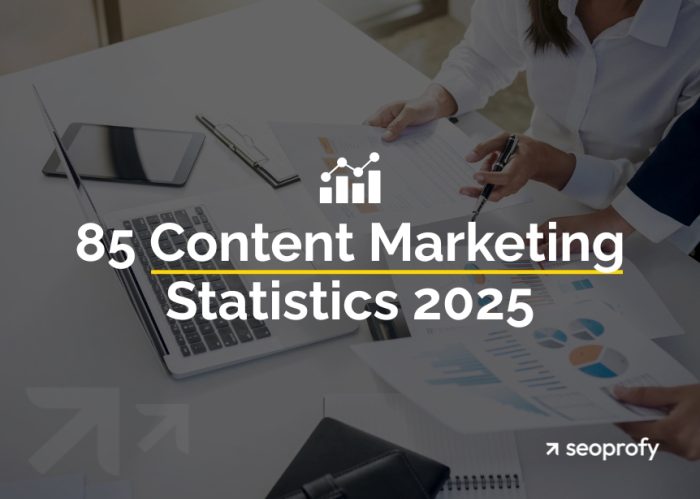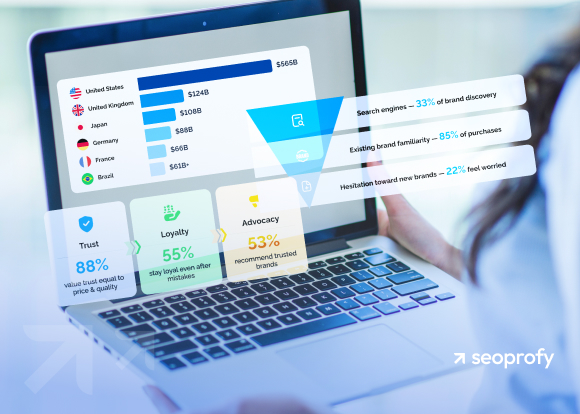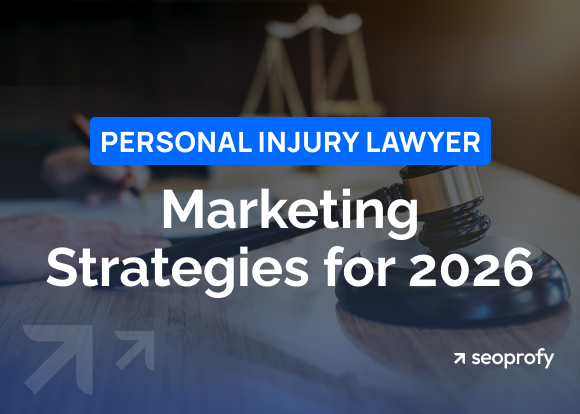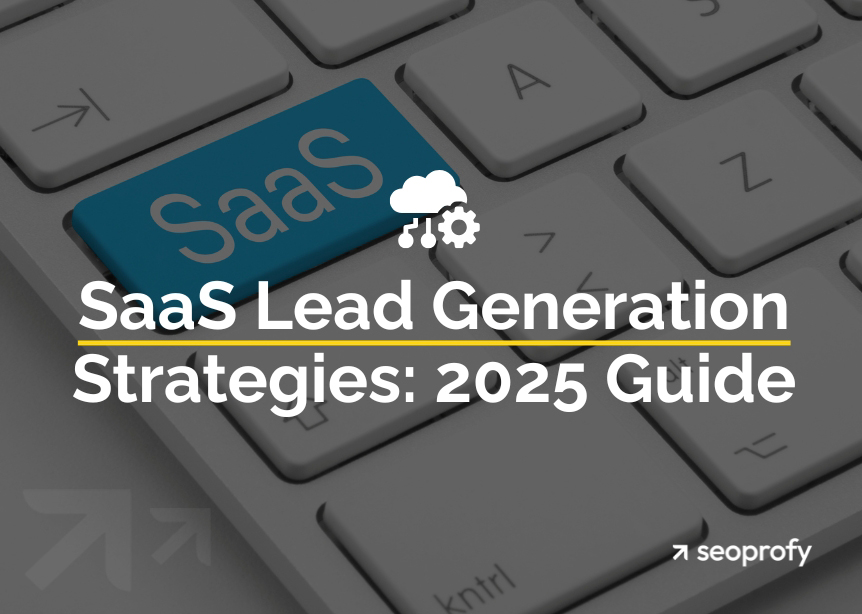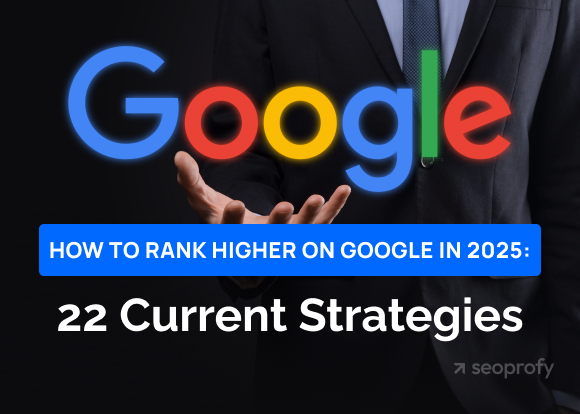Looking for the latest content marketing data to improve your digital marketing strategy and elevate your blog posts? Check our comprehensive report to discover useful insights and facts gathered from the most reputable online sources.
It’s essential to monitor content marketing trends to fully leverage their potential and improve your business. By adopting best practices and staying on top of key trends, you can establish strong brand authority and drive qualified traffic. The facts and data from our content marketing statistics 2025 will also help you better understand how to budget your campaigns depending on your business model. Also, you’ll find out how to estimate your content, the most effective formats and distribution channels, and future trends in this niche.
- 82% of modern businesses use content marketing.
- 58% of companies from different industries invest from $5,000 to $10,000 per month in their content.
- 95% of marketers highlight the importance of videos in their overall content marketing strategy.
- It takes from 1 to 2 months for AI-generated content to start ranking.
- Businesses that actively publish blog posts average 55% more visitors than those that don’t.
Adoption & Budget Statistics
The content marketing revenue worldwide constantly grows as more and more businesses start investing in their reach and visibility:
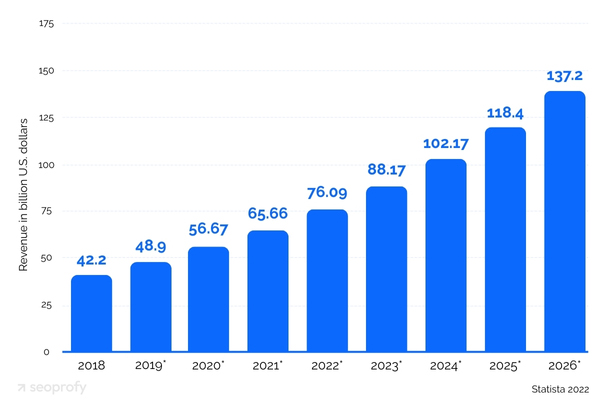
In addition to strengthening brand awareness, content can help you increase the organic traffic flow to your site and boost conversions. Use the content marketing data provided below to find out how businesses similar to yours plan their budgets to get the mentioned benefits and ensure their growth.
General Adoption
We’ve gathered recent data on content marketing adoption among businesses. The constantly increasing figures prove that producing high-quality content should be among the top priorities of any modern business.
- Global content marketing industry revenue is expected to reach $107 billion by 2026. (Statista)
- 82% of modern businesses use content marketing. (DemandSage)
- Over 4 in 5 modern marketers adopt content marketing techniques. (DemandSage)
- When it comes to content creation, 83% of marketers believe that it’s more effective to focus on quality over quantity. (HubSpot)
- 76% of content marketers use blogs to generate leads. (DemandSage)
B2B vs. B2C Adoption
The following B2B and B2C content marketing statistics compare how each business model adopts this approach. It’s essential to understand these key differences and consider them to properly plan the development and implementation of your content marketing campaign.
- 73% of B2B and 70% of B2C marketing experts include content marketing in their general marketing strategy. (DemandSage)
- 24% of B2B businesses still don’t have dedicated content marketing teams. (CMI)
- The average size of a content marketing team in 54% of B2B companies is from 2 to 5 people. (CMI)
- 42% of surveyed B2C marketers said only one person in their organizations is responsible for all types of content. (CMI)
- 58% of B2B marketers say that videos are the most efficient type of content. It’s followed by the case studies (53%), e-books (45%), research reports (45%), and short blog posts (45%). (CMI)
- Most B2B marketers (58%) say their content marketing strategy is moderately effective. (CMI)
- Only 2% of B2B articles generate 75% of social media shares. (Backlinko)
- The average B2C blog post gets 9.7x more shares than an article published on a B2B website. (Backlinko)
- 47% of B2B marketing specialists have a documented content strategy. (CMI)
- Only 37% of B2C marketers report having a documented content marketing strategy. (CMI)
- Millennials are the main age group targeted by both B2B (73%) and B2C (74%) marketers in 2025. (HubSpot)
- B2C content marketers primarily invest in social media and community building (57%). Other important areas include content quality improvement (45%), audience research, video content, and SEO. (Semrush)
Budget Allocation
The following content marketing facts can help you allocate the budget more effectively. Use them to thoroughly plan your resources and get the best possible results from your digital marketing efforts.
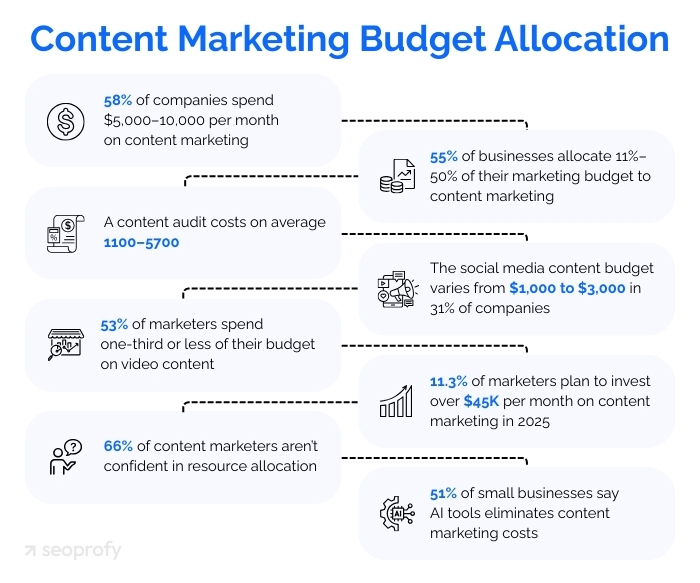
- 58% of companies operating in different industries spend from $5,000 to $10,000 per month on content marketing. (WebFX)
- 55% of businesses typically allocate from 11% to 50% of their marketing budget to content marketing. (WebFX)
- On average, a content audit costs from $100 to $700. (WebFX)
- The average budget on social media content in 31% of companies varies from $1000 to $3000. (WebFX)
- 53% of marketers spend about a third of their budget (or less) on video content. (Wyzowl)
- 71% of small businesses that don’t use AI technologies dedicate $1,000 or less to their monthly content marketing budget. Only 12% are eager to spend from $1,000 to $2,000. (Semrush)
- In 2025, 11.3% of marketers plan to invest over $45,000 on content marketing per month. This is 7,2% more “big spenders” compared to 2024. (Siegemedia)
- 66.5% of content marketing specialists aren’t sure how to properly allocate their resources. (Siegemedia)
- 51% of small businesses say they don’t incur extra costs on content marketing because they use AI tools. (Semrush)
ROI & Performance Statistics
Our content marketing statistics will help you understand how crafting top-quality content can support your business. Also, we’ll review which distribution channels ensure the highest return on investment (ROI).
Success Metrics
Use the essential data from the following content marketing statistics to understand how you can estimate the effectiveness of your publications. You can compare your results with the average in your industry to find out whether your approach needs any improvements.
- The main challenges for B2B marketers when measuring content performance are attributing ROI to content efforts and tracking customer journeys. (CMI)
- More than one in three marketing leaders say that conversion rates are the top KPI they prioritize when tracking content success. (HubSpot)
- Website traffic is among the two most common content success metrics. (HubSpot)
- Over 41% of marketers measure their content success through sales. (HubSpot)
- For 66% of businesses that use AI, traffic is the most important metric for tracking their content marketing results. (Semrush)
There are other metrics considered by marketers, which you can check in the table below:
| Metric | % of marketers using it to track content marketing success |
| Social media engagement and shares | 58% |
| Conversions and leads | 50% |
| On-page engagement | 48% |
| SERPs rankings | 43% |
| ROI | 38% |
| Backlinks and media mentions | 29% |
- Website and social media engagement are among the most tracked content metrics worldwide. (Statista)
- 66% of marketers measure the ROI of their videos through the engagement metrics such as likes, reposts, and shares. (Wyzowl)
- Short-form videos have the highest ROI (31%) among content formats. (DemandSage)
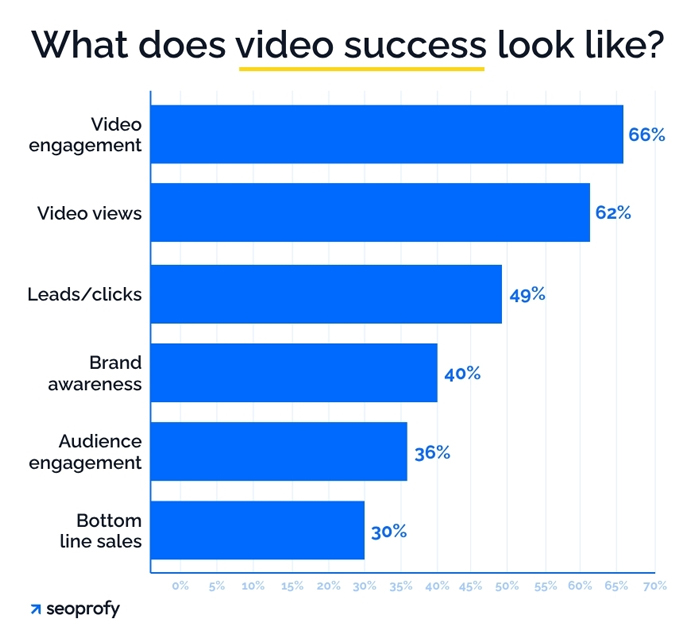
Check the table provided below to get acquainted with average return-on-investment rates for other types of content:
| Content Format | ROI |
| Images | 22% |
| Blog posts | 15% |
| Case studies | 15% |
| Audio content and podcasts | 14% |
- 77% of businesses claim to be satisfied with the ROI they receive from content marketing efforts. (WebFX)
- 93% of marketers claim video marketing ensures a good ROI. (Wyzowl)
- 79% of B2B marketing specialists say their content strategy helped them achieve their business goals, including brand awareness creation (87%), lead generation (74%), and audience nurturing (62%). (CMI)
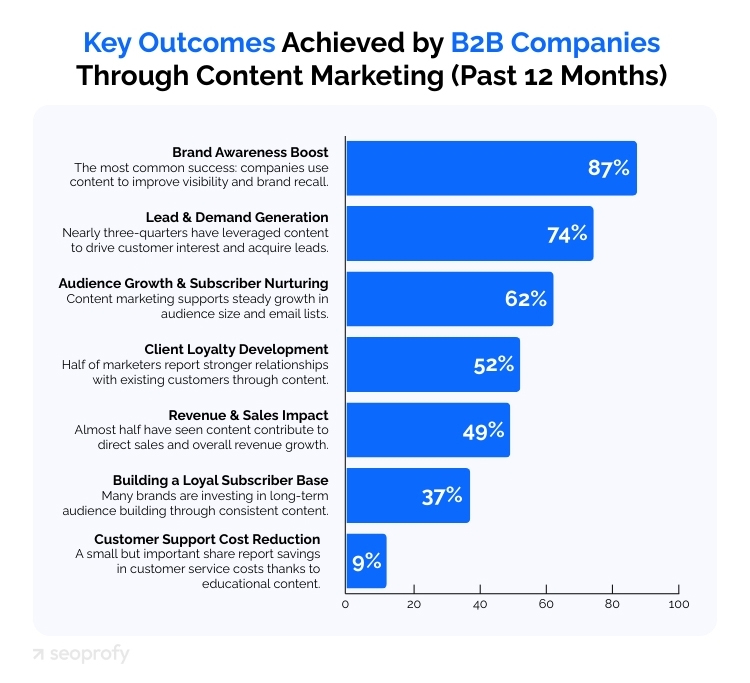
Distribution Channels
The following content marketing stats demonstrate the rise of new, efficient channels such as social media. At the same time, it also proves that investing in SEO remains critical as marketers claim it helps them increase brand awareness, generate leads, and nurture their audience.
- 89% of B2B marketers distribute their content via organic social media platforms. (CMI)
Other popular ways to reach the audience with their content include:
| B2B distribution channel | % of marketers using it |
| Blogs and corporate websites | 84% |
| Email newsletters | 71% |
| 63% | |
| In-person events and webinars | 55% |
- When it comes to social media, 85% of B2B marketers say that LinkedIn delivers the best value for their businesses. This platform is followed by Facebook (28%), YouTube (22%), Instagram (21%), X (7%), and TikTok (3%). (CMI)
- 64% of B2B marketers use search engine marketing and pay-per-click advertising, claiming they’re the most effective paid channels for content distribution. (CMI)
- 56% of businesses share content on social media, making it one of the most popular tactics for content promotion. Other popular techniques include SEO (32%), using Facebook groups (26%), PR/media relations (25%), and link building (19%). (CMI)
- Over 53% of site traffic comes from organic search, making SEO still one of the most effective channels for making your content visible online. (Ahrefs)
Content Format Statistics
Get acquainted with the following content statistics to find out which publications are the most popular with users in 2025. Adding them to your digital marketing strategy will help you increase engagement, promote your niche expertise, and drive sales.
However, what if you aren’t sure you can find the words that reach your clients right into the heart, inspiring them to purchase your products or services? Check the list of the best companies in the content creation niche to get assistance from professional masters of the pen.
Blogging & Written Content
Crafting publications for your blog is more complex than simply writing a few hundred words. Our content marketing data will help you understand the most effective trends to improve the readability and overall performance of your articles.
- In 2024, blog posts became the fourth most popular content format (19.47%) used by marketing experts. (HubSpot)
- Businesses that publish blog posts average 55% more visitors than those that don’t. (HubSpot)
- Nearly 80% of small business marketers report writing content on their own. At the same time, 17% hire writers and 14% opt for freelancers. (Semrush)
- How-to articles are the most popular type of content published by 74% of marketers. (Orbitmedia)
Other popular formats, which you can opt for to improve the performance of your blog, include:
| Content Format | % of marketers using it |
| Lists | 50% |
| Guides & eBooks | 46% |
| News and trend reviews | 45% |
| Opinion | 43% |
| Original researches | 43% |
| Interviews | 34% |
| Webinars | 26% |
| Infographics | 22% |
| Roundups | 22% |
- Roundups ensure the strongest results (28%), while other efficient content formats are infographics (25%), research (25%), interviews (24%), and webinars (24%). (Orbitmedia)
- The average blog post is nearly 1,400 words. (Orbitmedia)
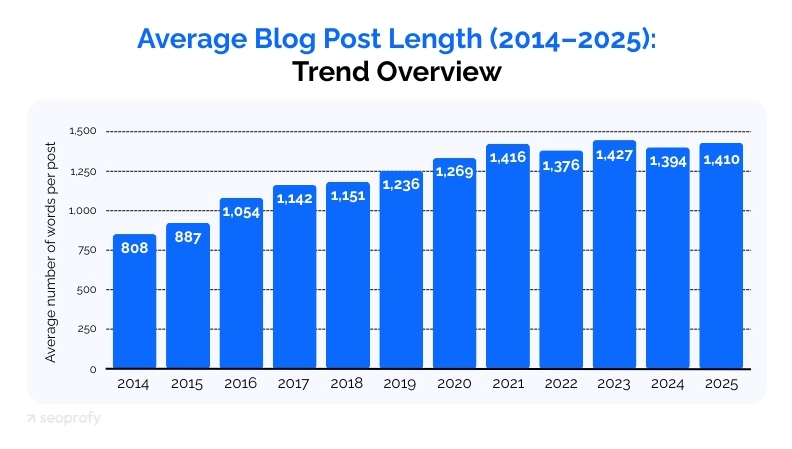
- The blog posts with over 2,000 words on average are likely to achieve stronger results. (Orbitmedia)
- Content longer than 3,000 words is 77.2% more likely to get more links than blog posts shorter than 1,000 words. (Backlinko)
- 94% of blog posts earn zero external links. (Backlinko)
- 70% of internet users are likely to learn about your company via your blog posts rather than ads. (SeoProfy)
Do you want your content not only to keep your visitors engaged but also to skyrocket your search engine rankings? Opt for our services to support your business with SEO-friendly blog posts that will attract your clients like a magnet.
Video & Visual Content
We’ve collected the content marketing statistics that show an increasing number of companies opt for videos to demonstrate the benefits of their products or services. Also, here you can find the data that highlights the effectiveness of this format for achieving your business goals.
- More than half of content marketing specialists opt for social videos (77%), branded stories (61%), and how-to videos (59%) as a part of their video marketing strategy. (CMI)
- In 2025, 89% of businesses use video as a marketing tool. (Wyzowl)
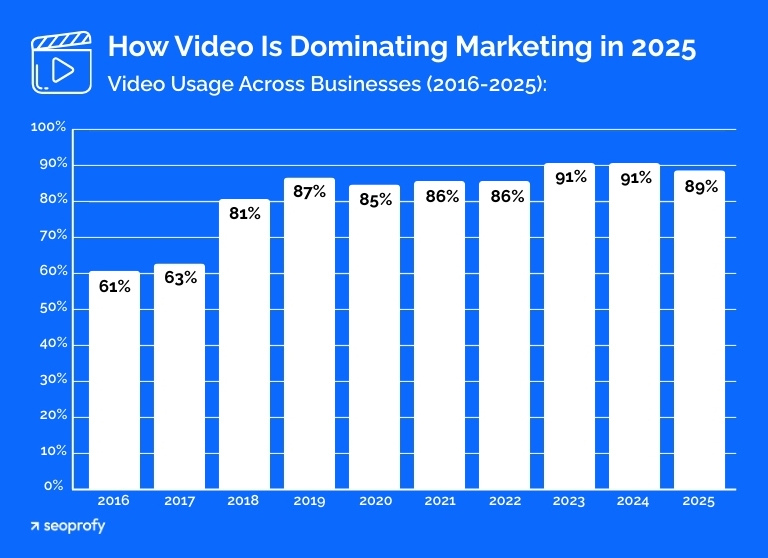
- 95% of video marketers admit that videos are an important part of their overall content marketing strategy. (Wyzowl)
- 99% of marketers say they’ve increased user understanding of their products or services with the help of videos. Moreover, this type of content also contributed to the growth in brand awareness for 96% of companies. (Wyzowl)
- 88% of marketers say they generated leads due to publishing videos. (Wyzowl)
- The top 3 social platforms for video content distribution are YouTube, LinkedIn, and Facebook. (CMI)
- Infographics can increase website traffic by 12%. (Demandsage)
- Blog posts with visuals have a 650% higher engagement rate. (Demandsage)
- 36% of content marketers claim that the optimal length for a video to achieve a marketing goal is between one and three minutes. (HubSpot)
Audio & Podcast Content
Although businesses often ignore launching a podcast, the following content marketing stats illustrate that this format may become a great complement to your marketing strategy.
- In 2025, the number of podcast listeners worldwide reached over 584 million, showing a 6.83% year-over-year growth. (Backlinko)
- It’s expected that there will be over 651 million podcast listeners in 2027. (Backlinko)
- 25% of marketing experts leverage audio content as part of their overall content marketing strategy. (HubSpot)
- On average, US citizens spend nearly 28 minutes per day listening to podcasts. (Emarketer)
- Podcasts account for 26.4% of the overall time spent with digital audio. (Emarketer)
- 61% of Gen Z customers report visiting a company’s website after listening to a podcast promoting its products or services. (Edison Research)
Interactive & Long‑Form Content
Developing top-quality interactive online tools, publishing quizzes, and creating interactive videos is essential for attracting new clients. Moreover, this type of content is the best for meeting customers’ informational intent, which plays an integral part in the buyer’s journey.
- Interactive content ensures 52.6% more engagement than static content. (Mediafly)
- On average, people spend 8.5 minutes on static content and 13 minutes on interactive content. (Mediafly)
- Businesses that opt for interactive content experience a 94% higher increase in content views. (Mediafly)
- 43% of buyers say that interactive features add value to videos and influence their decision-making process. (MarketingCharts)
- 88% of marketers say that interactive content helps differentiate their business from competitors. (Marketing Scoop)
- Business deals including interactive proposals or tools are likely to close 43% faster. (Marketing Scoop)
Are you looking for opportunities to drive sales? Discover more about strategies that can help you convert visitors into loyal customers with the help of top-quality interactive content.
AI & Future Trends Statistics
AI has already become an integral part of all modern industries, and the following content marketing statistics review the influence of this technology on the marketer’s work. Here you’ll discover how marketers use the potential of artificial intelligence and related noteworthy trends likely to shape the niche in the near future.
- 67% of small businesses and marketing specialists use AI for search engine optimization or content marketing. (Semrush)
- 89% of marketers use generative AI tools mainly to brainstorm new topics (62%), summarize content (53%), and write article drafts (44%). (CMI)
- Only 19% of B2B marketing teams have integrated AI into their daily processes. (CMI)
- 50% of writers use AI to boost the efficiency of their content. (HubSpot)
- 44% of B2B marketers estimate their AI-generated content as “good.” (CMI)
- Top AI applications in modern content marketing include content creation (35%), data analysis (30%), workflow automation (20%), and AI-powered research (15%). (HubSpot)
- 70% of marketers who use AI for advanced personalization have earned 200% ROI or even more from it. (Kibo Commerce)
- 23% of marketers report that their AI-generated content somewhat better performs in search engine rankings compared to human-written content. (Semrush)
- 39% of marketing specialists claim it takes from 1 to 2 months to rank with AI-generated content. (Semrush)
- AI tools can help increase content engagement by 25%. (HubSpot)
- 38% of marketers who don’t opt for AI for content creation say it takes up to 3 hours to write one long-form article. On the other hand, the experts who use AI tools reduce this time to less than 1 hour. (Semrush)
- Businesses, on average, use AI to create blog publications (58%) and social media posts (55%). Other types of content where marketers use artificial intelligence include short articles and videos, emails, and images. (Semrush)
Conclusion
Investments in data-driven content marketing must be among the top priorities of any modern business to achieve sustainable growth and success. At the same time, it’s essential to keep an eye on the latest trends and content marketing statistics to effectively benchmark your marketing strategies.
And if you need extra help with audience research, identifying your content’s weak points, or improving existing publications, SeoProfy is at your service! Our experts will help you develop a successful strategy and help your business reach new heights.


